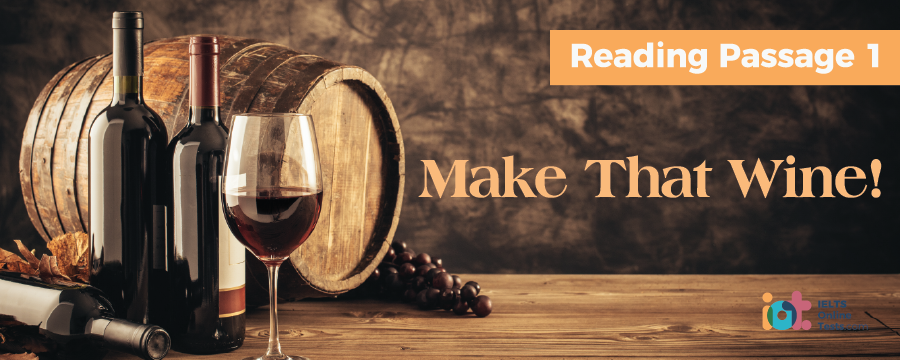
IELTS Mock Test 2021 February
- Đăng ngày: 21 Feb 2021
- Tests taken: 995,238
Đáp án
Part 1: Question 1 - 13
- 1 FALSE
- 2 TRUE
- 3 NOT GIVEN
- 4 FALSE
- 5 grape skin(s)
- 6 cabernet sauvignon
- 7 varietal
- 8 respect
- 9 vinification method
- 10 natural sugars
- 11 C
- 12 C
- 13 B
- 1 FALSE
- 2 TRUE
- 3 NOT GIVEN
- 4 FALSE
- 5 grape skin(s)
- 6 cabernet sauvignon
- 7 varietal
- 8 respect
- 9 vinification method
- 10 natural sugars
- 11 C
- 12 C
- 13 B
Part 2: Question 14 - 26
- 14 appropriate development
- 15 management gurus
- 16 complete aimlessness
- 17 personal values
- 18 (an) MBA
- 19 personalities and experiences
- 20 passionless and sterile
- 21 (a) superficial level
- 22 commitment
- 23 hard and tangible
- 24 C
- 25 A
- 26 B
- 14 appropriate development
- 15 management gurus
- 16 complete aimlessness
- 17 personal values
- 18 (an) MBA
- 19 personalities and experiences
- 20 passionless and sterile
- 21 (a) superficial level
- 22 commitment
- 23 hard and tangible
- 24 C
- 25 A
- 26 B
Part 3: Question 27 - 40
- 27 FALSE
- 28 TRUE
- 29 FALSE
- 30 NOT GIVEN
- 31 technological innovations
- 32 closest approach/launch window(s)
- 33 human body(ies)
- 34 lose (their) density
- 35 microbial exchange
- 36 alertness
- 37 bacterial infection(s)
- 38 micro-meteoroids,micro meteoroids,micrometeoroids
- 39 (frozen) water
- 40 dangerous occupations
- 27 FALSE
- 28 TRUE
- 29 FALSE
- 30 NOT GIVEN
- 31 technological innovations
- 32 closest approach/launch window(s)
- 33 human body(ies)
- 34 lose (their) density
- 35 microbial exchange
- 36 alertness
- 37 bacterial infection(s)
- 38 micro-meteoroids,micro meteoroids,micrometeoroids
- 39 (frozen) water
- 40 dangerous occupations
Leaderboard:
| # | Thành viên | Điểm | Thời gian | |
|---|---|---|---|---|
| Willow Ha |  | 9.0 | 15:22 | |
| niramay barot |  | 9.0 | 15:43 | |
| Smruthi S |  | 9.0 | 15:46 | |
| 4 | Sunaina Valluri |  | 9.0 | 15:48 |
| 5 | Usman Ali |  | 9.0 | 15:48 |
| 6 | Helen Cebrecus |  | 9.0 | 15:55 |
| 7 | Crist Dat |  | 9.0 | 16:03 |
| 8 | olgaabramova2006 |  | 9.0 | 16:12 |
| 9 | Nabwami Maria Gorethi |  | 9.0 | 16:16 |
| 10 | Leony Wulandari |  | 9.0 | 16:21 |
Tips for improving your ielts score

IELTS Practice free materials for listening
Since the IELTS is in a British accent, we would suggest listening to something in a British accent.
Giải thích chi tiết
Questions 1-4
Do the following statements agree with the information given in Reading Passage One?
Write
| TRUE | if the statement agrees with the information |
| FALSE | if the statement contradicts the information |
| NOT GIVEN | If there is no information on this |
1 Wine is popular in Australia because it is healthy.
2 Yeast is white-coloured.
3 Wine is popular in the Near East.
4 Blended wines are usually cheaper.
- 1 Answer: FALSE
Keywords in Questions
Similar words in Passage
Q1: Wine is popular in Australia because it is healthy.
Australia is a nation of beer drinkers. Actually, make that wine. Yes, wine has now just about supplanted beer as the alcoholic drink of choice, probably because of the extensive range of choices available and the rich culture behind them.
Note:
The keywords of Q1 are “wine” and “Australia”. Therefore, the needed information is in paragraph 1 which mentions about the popularity of wine in Australia.
In paragraph 1, it is inferred that wine is popular in Australia because the extensive range of choices available and the rich culture behind them.
It is also written in paragraph 1 that although wine drinkers seldom think about it, moderate consumption seems to be beneficial for the health. It means that the healthiness is not the main reason that drinkers consider when they drink wine.
However, in Q1, wine is popular in Australia because it is healthy.
Hence, the answer of Q1 is FALSE
- 2 Answer: TRUE
Keywords in Questions
Similar words in Passage
Q2: Yeast is white-coloured
Yeast grows naturally on many varieties of grapes, often visible as a white powder
Note:
The keyword of Q2 is “yeast”. Therefore, the needed information is in paragraph 2 which mentions about yeast.
It is written in paragraph 2 that yeast often visible as a white powder.
This information confirms the content of Q2.
Hence, the answer of Q2 is TRUE
- 3 Answer: NOT GIVEN
Keywords in Questions
Q3: Wine is popular in the Near East
Note:
The keywords of Q3 are “wine” and “Near East”. Since paragraph 2 mentions about the wine making in the Near East, the answer may appear in this paragraph.
According to paragraph 2, it is inferred that wine making started in the Near East at least 8000 years ago.
Besides this information, the passage does not mention any other information about the popularity of wine in the Near East at the moment.
Hence, the answer of Q3 is NOT GIVEN
- 4 Answer: FALSE
Keywords in Questions
Similar words in Passage
Q4: Blended wines are usually cheaper.
When one grape species is used, or is predominant, the wine produced is called varietal, as opposed to mixing the juices of various identified grapes, which results in blended wines … The latter process often results in some of the world’s most expensive bottles, such as the Cote Rotie wines in France.
Note:
The keyword of Q4 is “blended wines”. Since paragraph 4 contains information about blended wine, the answer may appear in this paragraph.
It is written in paragraph 4 that blended wines are often expensive.
The passage is contrast to the information of Q4, which is written that blended wines are usually cheaper.
For this reason, the answer of Q4 is FALSE
Questions 5-10
Complete the table.
Choose NO MORE THAN TWO WORDS from the passage for each answer.
Classification based on | Associated Fact | Related Example |
colour | Red wines use 5 in fermentation. | 6 |
grape species | can be 7 or blended | Cote Rotie wines |
location | Drinkers of wine 8 this. | Barossa Valley |
9 | can allow 10 to remain | dessert wine |
- 5 Answer: grape skin(s)
Keywords in Questions
Similar words in Passage
Q5: Red wines use ________ in fermentation.
Red wines are produced by leaving the grape skin in contact with the juice during fermentation
Note:
The blank should be a noun as it follows the verb “use”
Q5 is about the associated fact of red wines that are classified based on the colour. Since paragraph 3 mentions about the classification based on the colour and contains information about Q5’ keyword “red wine”, the answer may appear in this paragraph.
According to paragraph 3, it is inferred that red wines use grape skin during fermentation.
Therefore, the answer of Q5 is “grape skin”
- 6 Answer: cabernet sauvignon
Keywords in Questions
Similar words in Passage
Q6: _________
The cabernet sauvignon grape, a key ingredient in the world’s most widely recognised, and similarly named, red wines.
Note:
The blank should be the name of a wine.
Q6 is about the a related example of red wines. Since paragraph 3 and 4 contains information about red wines, the answer may appear in these paragraphs.
According to paragraph 4, it is stated that the cabernet sauvignon grape, a key ingredient in the world’s most widely recognised, and similarly named, red wines.
Therefore, the answer of Q6 is “ cabernet sauvignon”
- 7 Answer: varietal
Keywords in Questions
Similar words in Passage
Q7: can be ________ or blended
When one grape species is used, or is predominant, the wine produced is called varietal, as opposed to mixing the juices of various identified grapes, which results in blended wines.
Note:
The blank should be a noun or an adjective as it follows the verb “be”
Q7 is about the associated fact of wines that are classified based on the grape species. Since paragraph 4 mentions about the classification based on the grape species and contains information about Q7’ keyword “blended”, the answer may appear in this paragraph.
According to paragraph 4, it is inferred that based on the grape species, wine can be classified as varietal or blended.
Therefore, the answer of Q7 is “varietal”
- 8 Answer: respect
Keywords in Questions
Similar words in Passage
Q8: Drinkers of wine _______ this
Traditional wines made in these places carry trademarks, respected by serious wine drinkers.
Note:
The blank should be a verb as it follows the noun “drinkers of wine”
Q8 is about the associated fact of wines that are classified based on location. Since paragraph 5 mentions about the classification based on the location and contains information about Q8’ keyword “drinkers of wine”, the answer may appear in this paragraph. Use the hint “Barossa Valley” in the table to locate the answer more easily.
In paragraph 5, it is stated that wine drinkers respect traditional wines made in places carry trademarks such as Barossa Valley.
Therefore, the answer of Q8 is “respect”
- 9 Answer: vinification method
Keywords in Questions
Similar words in Passage
Q9: ____
We come to the vinification method as a means of classification.
Note:
The blank should be a noun (a means of classification).
Q9 is about a means of wine classification. Since paragraph 3, 4, 5, 6 contains information about wine classification, the answer may appear in these paragraphs.
In paragraph 6, it is written that we come to the vinification method as a means of classification.
Additionally, according to paragraph 6, dessert wine is a related example for wines classified based on vinification method.
Therefore, the answer of Q9 is “ vinification method”
- 10 Answer: natural sugars
Keywords in Questions
Similar words in Passage
Q10: can allow ____ to remain
Another variation is to stop the fermentation before all the natural sugars are consumed, creating dessert wines.
Note:
The blank should be a noun as it follows the verb “allow”
Q10 is about the associated fact of wines that are classified based on vinification method. Since paragraph 6 mentions about the classification based on vinification method, the answer may appear in this paragraph.
In paragraph 6, it is written that another variation is to stop the fermentation before all the natural sugars are consumed, creating dessert wines. It means that dessert wines, which are related example of Q10, can allow natural sugars remain.
Therefore, the answer of Q10 is “natural sugars”. Remember that the answer must be in plural form
Questions 11-13
Choose the correct letter, A, B, C, or D.
Vintage wines are
- A
- B
- C
- D
Keywords in Questions | Similar words in Passage |
Q11: Vintage wines are ____
| The appreciation and assessment of wine is an inexact science, meaning that the significance of a particular vintage often promotes much speculation and disagreement. |
Note:
| |
The author thinks that wine terminology is
- A
- B
- C
- D
Keywords in Questions | Similar words in Passage |
Q12: The author thinks that wine terminology is ____
| This leads to the rich and varied world of wine assessment, and its descriptive terminology. |
Note:
| |
Wine
- A
- B
- C
- D
Keywords in Questions | Similar words in Passage |
Q13: Wine ____
| To this day, the biggest drinkers of wine remain the Mediterranean countries, with France leading the way. |
Note:
| |
Reading Passage 1
You should spend about 20 minutes on Questions 1-13, which are based on Reading Passage One.

Make That Wine!
Australia is a nation of beer drinkers. Actually, make that wine. Yes, wine has now just about supplanted beer as the alcoholic drink of choice, probably because of the extensive range of choices available and the rich culture behind them. This all adds a certain depth and intimacy to the drinking process which beer just cannot match. In addition, although wine drinkers seldom think about it, moderate consumption seems to be beneficial for the health, lowering the incidence of heart disease and various other ailments.
Wine is the product of the fermentation of grape juice, in which yeast (a fungus) consumes the natural sugars within, producing alcohol and carbon dioxide as waste. Yeast grows naturally on many varieties of grapes, often visible as a white powder, and causing fermentation directly on the plant. Thus, the discovery of wine-making was inevitable at some stage in human history. The evidence shows that this was at least 8,000 years ago in the Near East. From there, wine-making spread around the ancient Mediterranean civilisations, where the liquid was extensively produced, drunk, and traded. To this day, the biggest drinkers of wine remain the Mediterranean countries, with France leading the way.
This leads to the classification of wines, which is quite complex. It often begins with the colour: red or white. Most people do not know that the colour of wine is not due to the grapes used (whose skins are either green or purple), but to the wine-making process itself. All grape juice is clear. Red wines are produced by leaving the grape skin in contact with the juice during fermentation; white wines by not doing so. Thus, white wine can be made from dark-coloured grapes, provided that the skin is separated early, although the resultant wine may have a pinkish tinge.
A similar wine classification is based more specifically on the grape species used, giving such well-known names as Pinot Noir and Merlot. Chardonnay grapes remain one of the most widely planted, producing an array of white wines, rivaling the cabernet sauvignon grape, a key ingredient in the world’s most widely recognised, and similarly named, red wines. When one grape species is used, or is predominant, the wine produced is called varietal, as opposed to mixing the juices of various identified grapes, which results in blended wines. The latter process is often done when wine-makers, and the people who drink their product, want a consistent taste, year after year. Far from being looked down upon, it often results in some of the world’s most expensive bottles, such as the Cote Rotie wines in France.
Increasingly, however, market recognition is based on the location of the wine production, resulting in labels such as Bordeaux in France, Napa Valley in California, and the Barossa Valley in Australia. Traditional wines made in these places carry trademarks, respected by serious wine drinkers. However, an example of the blurred lines is the term ‘champagne’. This was once expected to be made from grapes grown in the Champagne region of France, with all the expertise and traditions of that area, but, despite legal attempts to trademark the term, it has become ‘semi-generic’, allowing it to be used for any wine of this type made anywhere in the world.
Finally, we come to the vinification method as a means of classification. One example is, in fact, champagne, known as a ‘sparkling’ wine. By allowing a secondary fermentation in a sealed container, it retains some of the waste carbon dioxide. Another variation is to stop the fermentation before all the natural sugars are consumed, creating dessert wines, ranging from slight to extreme sweetness. Yet again, grapes can be harvested well beyond their maximum ripeness, creating 'late harvest wines’, or allowed to become partially dried (or ‘raisoned’), creating ‘dried grape wines’. Clearly, there are many possibilities, all producing uniquely flavoured products.
One of the best-known terms relating to wine is ‘vintage’. This signifies that the product was made from grapes that were grown in a single labeled year. If that year is eventually acknowledged to have produced exceptionally fine grapes and resultant wines (‘a good vintage’), bottles from that period are often saved for future consumption. Of course, the appreciation and assessment of wine is an inexact science, meaning that the significance of a particular vintage often promotes much speculation and disagreement. A non-vintage wine is usually a blend from the produce of two or more years, which is done, as mentioned before, for consistency and quality control.
This leads to the rich and varied world of wine assessment, and its descriptive terminology. Wine has such a variety of aromas, flavours, textures, and aftertastes that serious wine drinkers demand an agreed vocabulary so that the drinking sensations can be reliably described in writing. From bouquet to biscuity, mellow to musky, vivid to vegetal, the conceited connoisseur can perplex the listener with some really purple prose. Perhaps the opportunity to posture pretentiously with all this jargon is the main reason why wine enthusiasts are so taken with this product. Cheers!






